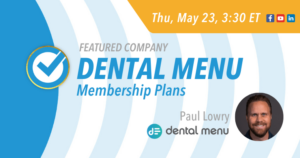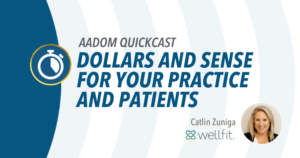AADOM QUICKcast: Best Practices in Membership Plan Revenue Cycle Management
Video Description:
Streamlining Membership Plan Revenue and Production: Best Practices and Common Challenges
Membership plans are becoming increasingly popular in the dental industry, as they offer patients an affordable way to receive regular dental care and help dental practices build a loyal patient base. However, managing membership plans can be a complex and time-consuming process for dental teams. In this presentation, we’ll explore some best practices for managing membership plans and common challenges that dental teams may face.
Course Learning Objectives:
- To provide dental teams with best practices for managing membership plan payments, specifically how to keep the patient ledger clean and accurate.
- To highlight common challenges that dental teams may face when managing membership plans and to offer a different way of thinking about what a membership plan is; how it should mimic insurance with regards to eligibility, production, and collections.
- To provide solutions for addressing these challenges, especially for compensating providers and tracking accurate production.
Sponsored by: Plan Forward
Streamlining Membership Plan Revenue and Production: Best Practices and Common Challenges
Membership plans are becoming increasingly popular in the dental industry, as they offer patients an affordable way to receive regular dental care and help dental practices build a loyal patient base. However, managing membership plans can be a complex and time-consuming process for dental teams.
In this article, we’ll explore some best practices for managing membership plans and common challenges that dental teams may face.
Making Membership Plans Mimic Insurance
One of the biggest challenges dental teams face when managing membership plans is handling payments that do not coincide with a date of service.
We are all used to the insurance model, where the monthly premiums are paid but never seen by the practice. Instead, we check eligibility and remaining benefits to determine if a patient can receive services that day under that benefit plan. If the answer is yes, then services are rendered, a charge is posted for that date, and a subsequent payment is received for that same date of service.
Dental teams can make membership plans easier to manage by structuring them in a similar way.
To do this, dental teams can use insurance companies and fee schedules, just like they would with a PPO plan. When a patient joins the membership plan, the payment is not posted in their ledger. (I know, it feels icky.) But remember, these membership payments are like the premiums. The membership payment simply gives the patients access to services under that benefit plan. Instead of posting the “premium” on the ledger, the appropriate “insurance company” is applied to the patient account along with a corresponding fee schedule.
Similar to insurance, eligibility for a membership patient is checked prior to every appointment ensuring services are only rendered when the membership payments are current.
Another way to make membership plans mimic insurance is to offer a tiered system of benefits.
For example, a basic membership plan may include two cleanings and exams per year, while a premium plan may include additional services like fluoride treatments and x-rays. This allows patients to choose the plan that best fits their needs and budget.
Managing Membership Plan Payments and Collections
Another challenge dental teams face when managing membership plans is:
a) showing a huge list of account credits, or
b) showing balances if monthly payments are not caught up to the production posted.
This causes A/R managers to constantly suppress statements or miss sending statements to members who may have a balance for restorative work. To ensure that patient balances are accurate, all membership services that are included in the plan (in-plan services) should be posted on the patient account with zero as the adjusted production.
With an integrated membership software like Plan Forward, the software will track gross and adjusted production and collections for these in-plan services once services are rendered, and reports can be generated with the click of a button.
When an integrated software is not being utilized, best practice would be to create specific adjustment types and run production by provider reports based on these adjustment types to get this data. This typically takes a few extra steps to calculate commission for providers but it’s doable.
It’s also important to note that membership plan payments should not be considered collections the moment they are processed. When a patient makes a membership plan payment, it essentially goes to the “house,” like premiums paid to an insurance company. You would only want to give credit to those collections once the services are rendered. (i.e. if you are paying associates on collections, you will only want to pay their percentage on collections when the preventive care services are completed. If the patient does not use all their services, this membership revenue stays with the “house” and is not paid out to the providers.)
Compensating Providers for Membership Plan Patients
It is critical that compensation for providers when seeing membership plan patients is the same as any other patient.
If providers are not getting compensated for these patients or are getting compensated less or in a different way than insured/cash patients, it could disincentivize them from wanting to see these patients.
This is the worst thing that dental teams can do, as membership plan patients are valuable and produce more revenue than any other type of patient.
To avoid this, dental teams should ensure that all reporting and compensation is the same for membership plan patients as it is for other patients.
This means that providers should be compensated just like they would be for any other patient, whether it be gross or adjusted production, or collections. This goes for team bonuses as well. All of this production and collections needs to be factored into team goals, or there will be misalignment with interest in growing the plan.
If dental teams are using an integrated software, they can easily generate reports that show the compensation for each provider based on the services they provided and overall production completed. If dental teams are not using an integrated software, they will need to create specific adjustment types and run these reports. This may take more time and effort, but it’s important to ensure that providers are compensated consistently across the board for their work.
Visit https://www.planforward.io/ for more information.
Learn about the presenter:
Megan Lohman is the founder and co-CEO of Plan Forward, a SaaS platform supporting membership plans for dental practices. As an office manager and treatment coordinator, Megan witnessed first-hand the issues dental practices were facing with membership plans and built Plan Forward to be an innovative resource for dental practices to drive growth and support the practices role in exceptional care for their patients.
Megan has authored many articles for leading dental publications and speaks nationally for many dental associations, study clubs, and meetings.






